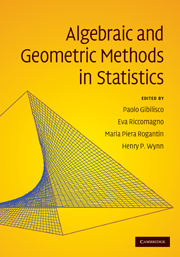Book contents
- Frontmatter
- Contents
- List of contributors
- Preface
- Frequently used notations and symbols
- 1 Algebraic and geometric methods in statistics
- Part I Contingency tables
- Part II Designed experiments
- Part III Information geometry
- 14 Introduction to non-parametric estimation
- 15 The Banach manifold of quantum states
- 16 On quantum information manifolds
- 17 Axiomatic geometries for text documents
- 18 Exponential manifold by reproducing kernel Hilbert spaces
- 19 Geometry of extended exponential models
- 20 Quantum statistics and measures of quantum information
- Part IV Information geometry and algebraic statistics
- Part V On-line supplements
16 - On quantum information manifolds
from Part III - Information geometry
Published online by Cambridge University Press: 27 May 2010
- Frontmatter
- Contents
- List of contributors
- Preface
- Frequently used notations and symbols
- 1 Algebraic and geometric methods in statistics
- Part I Contingency tables
- Part II Designed experiments
- Part III Information geometry
- 14 Introduction to non-parametric estimation
- 15 The Banach manifold of quantum states
- 16 On quantum information manifolds
- 17 Axiomatic geometries for text documents
- 18 Exponential manifold by reproducing kernel Hilbert spaces
- 19 Geometry of extended exponential models
- 20 Quantum statistics and measures of quantum information
- Part IV Information geometry and algebraic statistics
- Part V On-line supplements
Summary
Introduction
The aim of information geometry is to introduce a suitable geometrical structure on families of probability distributions or quantum states. For parametrised statistical models, such structure is based on two fundamental notions: the Fisher information and the exponential family with its dual mixed parametrisation, see for example (Amari 1985, Amari and Nagaoka 2000).
For the non-parametric situation, the solution was given by Pistone and Sempi (Pistone and Sempi 1995, Pistone and Rogantin 1999), who introduced a Banach manifold structure on the set P of probability distributions, equivalent to a given one. For each µ ∈ ρ, the authors considered the non-parametric exponential family at µ. As it turned out, this provides a C∞-atlas on ρ, with the exponential Orlicz spaces Lφ(µ) as the underlying Banach spaces, here φ is the Young function of the form φ(x) = cosh(x) — 1.
The present contribution deals with the case of quantum states: we want to introduce a similar manifold structure on the set of faithful normal states of a von Neumann algebra M. Since there is no suitable definition of a non-commutative Orlicz space with respect to a state φ, it is not clear how to choose the Banach space for the manifold. Of course, there is a natural Banach space structure, inherited from the predualM. But, as it was already pointed out in (Streater 2004), this structure is not suitable to define the geometry of states: for example, any neighbourhood of a state φ contains states such that the relative entropy with respect to φ is infinite.
- Type
- Chapter
- Information
- Algebraic and Geometric Methods in Statistics , pp. 265 - 276Publisher: Cambridge University PressPrint publication year: 2009



